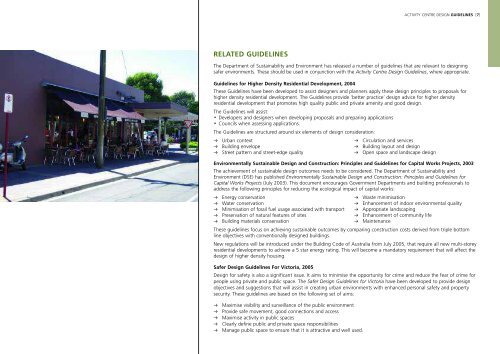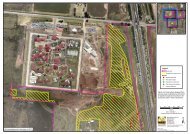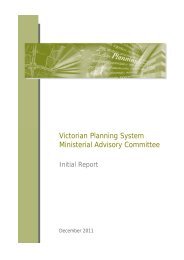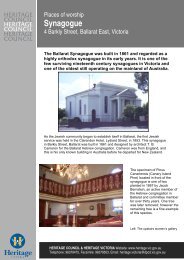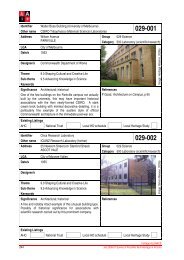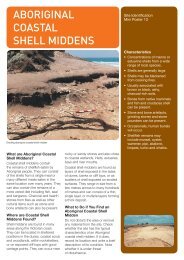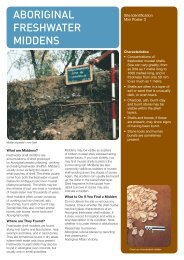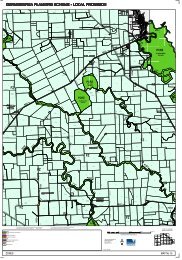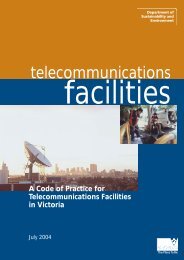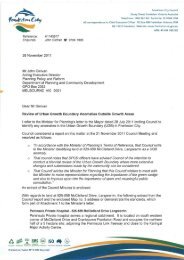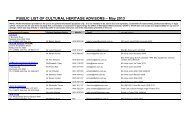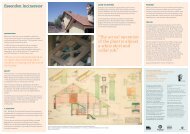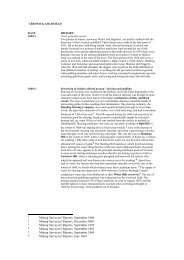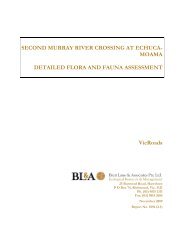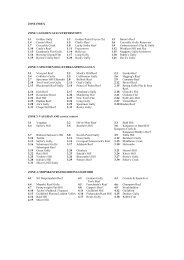Activity Centre Design Guidelines - Department of Planning and ...
Activity Centre Design Guidelines - Department of Planning and ...
Activity Centre Design Guidelines - Department of Planning and ...
You also want an ePaper? Increase the reach of your titles
YUMPU automatically turns print PDFs into web optimized ePapers that Google loves.
RELATED GUIDELINES<br />
The <strong>Department</strong> <strong>of</strong> Sustainability <strong>and</strong> Environment has released a number <strong>of</strong> guidelines that are relevant to designing<br />
safer environments. These should be used in conjunction with the <strong>Activity</strong> <strong>Centre</strong> <strong>Design</strong> <strong>Guidelines</strong>, where appropriate.<br />
<strong>Guidelines</strong> for Higher Density Residential Development, 2004<br />
These <strong>Guidelines</strong> have been developed to assist designers <strong>and</strong> planners apply these design principles to proposals for<br />
higher density residential development. The <strong>Guidelines</strong> provide ‘better practice’ design advice for higher density<br />
residential development that promotes high quality public <strong>and</strong> private amenity <strong>and</strong> good design.<br />
The <strong>Guidelines</strong> will assist:<br />
• Developers <strong>and</strong> designers when developing proposals <strong>and</strong> preparing applications<br />
• Councils when assessing applications.<br />
The <strong>Guidelines</strong> are structured around six elements <strong>of</strong> design consideration:<br />
p Urban context<br />
p Building envelope<br />
p Street pattern <strong>and</strong> street-edge quality<br />
Environmentally Sustainable <strong>Design</strong> <strong>and</strong> Construction: Principles <strong>and</strong> <strong>Guidelines</strong> for Capital Works Projects, 2003<br />
The achievement <strong>of</strong> sustainable design outcomes needs to be considered. The <strong>Department</strong> <strong>of</strong> Sustainability <strong>and</strong><br />
Environment (DSE) has published Environmentally Sustainable <strong>Design</strong> <strong>and</strong> Construction: Principles <strong>and</strong> <strong>Guidelines</strong> for<br />
Capital Works Projects (July 2003). This document encourages Government <strong>Department</strong>s <strong>and</strong> building pr<strong>of</strong>essionals to<br />
address the following principles for reducing the ecological impact <strong>of</strong> capital works:<br />
p Energy conservation<br />
p Water conservation<br />
p Minimisation <strong>of</strong> fossil fuel usage associated with transport<br />
p Preservation <strong>of</strong> natural features <strong>of</strong> sites<br />
p Building materials conservation<br />
These guidelines focus on achieving sustainable outcomes by comparing construction costs derived from triple bottom<br />
line objectives with conventionally designed buildings.<br />
New regulations will be introduced under the Building Code <strong>of</strong> Australia from July 2005, that require all new multi-storey<br />
residential developments to achieve a 5 star energy rating. This will become a m<strong>and</strong>atory requirement that will affect the<br />
design <strong>of</strong> higher density housing.<br />
Safer <strong>Design</strong> <strong>Guidelines</strong> For Victoria, 2005<br />
<strong>Design</strong> for safety is also a significant issue. It aims to minimise the opportunity for crime <strong>and</strong> reduce the fear <strong>of</strong> crime for<br />
people using private <strong>and</strong> public space. The Safer <strong>Design</strong> <strong>Guidelines</strong> for Victoria have been developed to provide design<br />
objectives <strong>and</strong> suggestions that will assist in creating urban environments with enhanced personal safety <strong>and</strong> property<br />
security. These guidelines are based on the following set <strong>of</strong> aims:<br />
p Maximise visibility <strong>and</strong> surveillance <strong>of</strong> the public environment<br />
p Provide safe movement, good connections <strong>and</strong> access<br />
p Maximise activity in public spaces<br />
p Clearly define public <strong>and</strong> private space responsibilities<br />
p Manage public space to ensure that it is attractive <strong>and</strong> well used.<br />
p Circulation <strong>and</strong> services<br />
p Building layout <strong>and</strong> design<br />
p Open space <strong>and</strong> l<strong>and</strong>scape design<br />
ACTIVITY CENTRE DESIGN GUIDELINES [7]<br />
p Waste minimisation<br />
p Enhancement <strong>of</strong> indoor environmental quality<br />
p Appropriate l<strong>and</strong>scaping<br />
p Enhancement <strong>of</strong> community life<br />
p Maintenance


